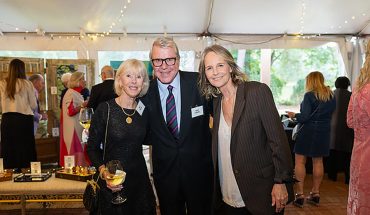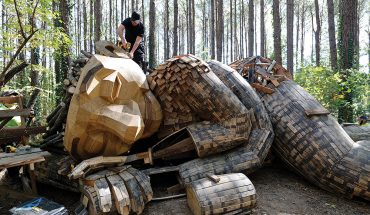
Goodnight’s collection fills the SAS founder’s extensive office suite. He holds Pyrite Cubes in matrix from Navajun, Spain. The green mineral beside him is Prehnite from the Sichuan Province, China.
by Catherine Kimrey Breeden
photographs by Jimmy Williams
“When I was a young boy, about 10 or 11 years old,” says Jim Goodnight, “and living on the edge of town in Greensboro, I’d venture out into the surrounding area and look for arrowheads and quartz crystals.”
Years passed, and Goodnight’s boyhood fascination with natural objects found in or beneath the earth’s crust took a back seat to other interests while he earned distinction as one of the nation’s most successful entrepreneurs. The founder of multi-billion-dollar business analytics software giant SAS, Goodnight is also a philanthropist and advocate for education.
“Then,” Goodnight says, “about 20 years ago I was at an antique store in Blowing Rock and saw a couple of nice specimens and thought they would look nice at home. That’s when I started collecting.”
And so – with the purchase of a banded fluorite from China and a kyanite cluster from Brazil – began a significant mineral collection that sparkles and shines in the corridor leading to Goodnight’s office at Cary’s SAS headquarters.
Numbering more than 400 items, the collection throws off every color of the spectrum and spills over into his office and conference room. Each specimen sits atop a Plexiglas pedestal. The name and provenance of each mineral is etched into its base.
A year after his initial purchase, Goodnight says, he was in Sedona, Ariz., where 10 more minerals caught his eye. That began Goodnight’s habit, one that continues to this day, of buying 10 to 12 minerals, rocks, fossils – or perhaps a meteorite, dinosaur egg, or piece of fossilized wood – every year. Goodnight travels to gem and mineral shows to find the new additions. He says he goes with an open mind and selects only those objects that strike his fancy.
For a man known to be taciturn and private, Goodnight is passionate and forthcoming when discussing his hobby. “Lately what I look for are things that are old and unusual,” he says. “Just looking at the beauty of nature and all the things that have been created inside the earth, you have to be amazed by all the colors and formations that are out there.”
This emphasis on beauty is consistent with the sensibility of a man who, with his wife Ann, is a noted patron and collector of the visual arts. He credits her with the idea, as his collection grew, of incorporating museum-style shelving in his office suite to house his treasures. He also mentions, as an aside, that she had made it clear there would be no rocks in their home library.
As he shows a visitor around, it is obvious that Goodnight, a self-described “science and math person,” loves each piece of his collection. He points first to one and then another, extolling its color, structure, texture, point of origin, and other features that drew him to it. He picks up and cradles individual pieces, some quite fragile, in his large hands as he points out their appealing aspects.
Here is pyrite from Peru, displaying the naturally occurring cube shapes that distinguish the mineral; there is pure white quartz from India looking like a cluster of icy snowballs; here is brilliant green malachite from the Republic of Congo; there is glowing purple fluorite, a perfectly preserved specimen presented on its matrix of sphalerite, from Tennessee. There is a 70-million-year-old nautilus-shaped fossil from Oklahoma; nearby sits a fossilized dinosaur egg from the Gobi Desert in Mongolia.
Viewing these treasures from nature, Goodnight describes their sculptural shapes and saturated colors as being the “first art; art that can’t be replicated by man.”

A recent acquisition that Goodnight particularly prizes is a piece of crystallized gold from Kalgoorlie, West Australia. He explains that the specimen, with its intricate and perforated shape, is rare because, unlike most gold, it has not been smoothed by water. And he mentions that North Carolina was one of the first gold-producing states.
The collection contains a number of pieces from North Carolina, among them emerald on limonite from Hiddenite, which for many years had the only known emerald deposits in North America; mica and red garnet from Spruce Pine; agate from Reedy Creek in Raleigh; pyrite on quartz from Cary; quartz with chlorite from Durham; and pyrite in pyrophyllite and quartz from Glendon.
Nineteen states are represented – from California with its pink halite to New York with its double-terminated crystal Herkimer diamond.
All told, the Goodnight collection contains specimens from some 40 countries, ranging alphabetically from Afghanistan with its bicolor tourmaline to Zaire with its stunning combination of malachite and chrysocolla.
While not many people are privileged to view and appreciate the collection in its entirety, Goodnight has loaned some special pieces to the North Carolina Museum of Natural Sciences, where they can be seen by the public.
Betsy Bennett, the museum’s former director – for whom the Betsy M. Bennett Bridge to Discovery connecting the museum to its Nature Research Center wing is named – collaborated with Goodnight to select the 24 minerals displayed on that bridge.
She is enthusiastic about the educational opportunities these specimens provide, and with their “wow factor,” which she says encourages learning in the museum setting. Bennett finds it gratifying to watch families and school groups discover and exclaim over the minerals, pointing out that the display also dovetails nicely with Goodnight’s longtime work to improve education for all children.
Back in his office, Goodnight keeps a favored piece, a large citrine from Brazil, behind his desk. This golden colored quartz – known as “The Merchant’s Stone” – is associated with success, personal power, prosperity and abundance, especially in business. It is also said to promote generosity and sharing.
While Goodnight says that he doesn’t consider any of his minerals to be good-luck charms, the qualities attributed to citrine quartz are clearly reflected in his life as a visionary innovator and generous community contributor.
In a poetic turn, Goodnight’s collection also contains two arrowheads that were discovered on the very site where SAS is located. Those arrowheads date to the Archaic Period, which is the second oldest known cultural period in North Carolina (c.8000 B.C. to c.1000 B.C.).
The serendipity of this occurrence, bringing the past into the present, raises the question of whether Jim Goodnight’s Merchant’s Stone just might have some magical properties, whether he believes so or not.




